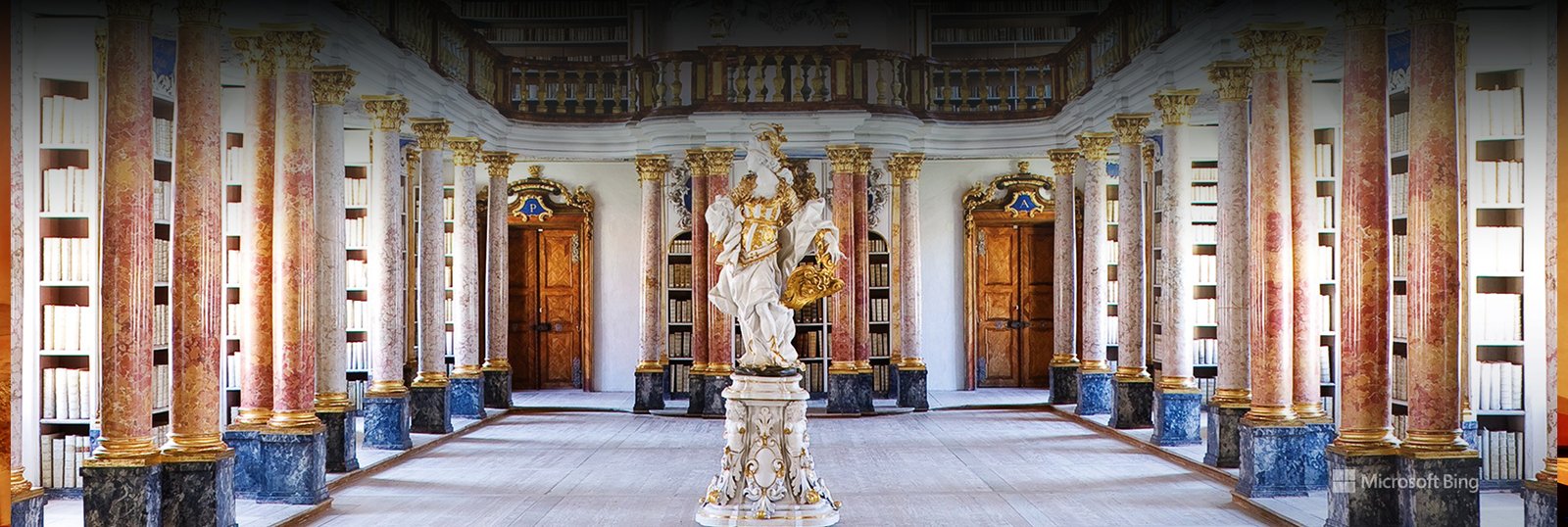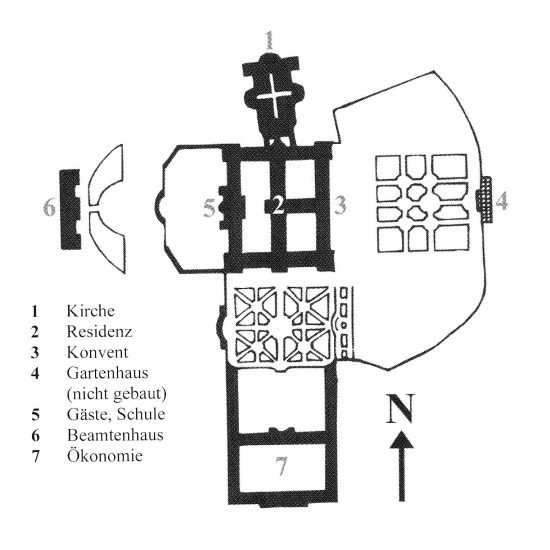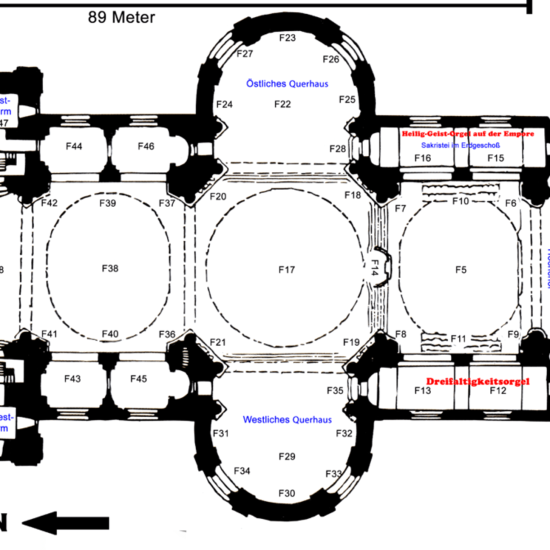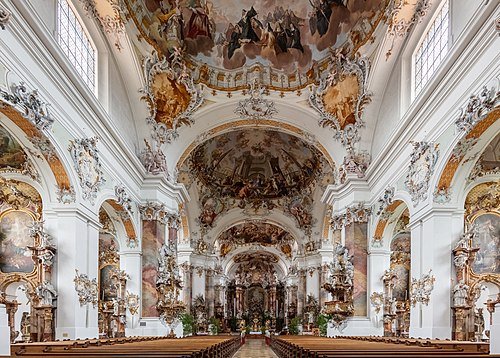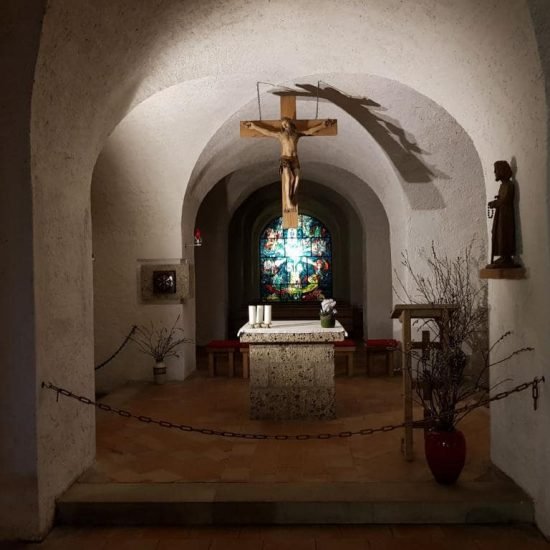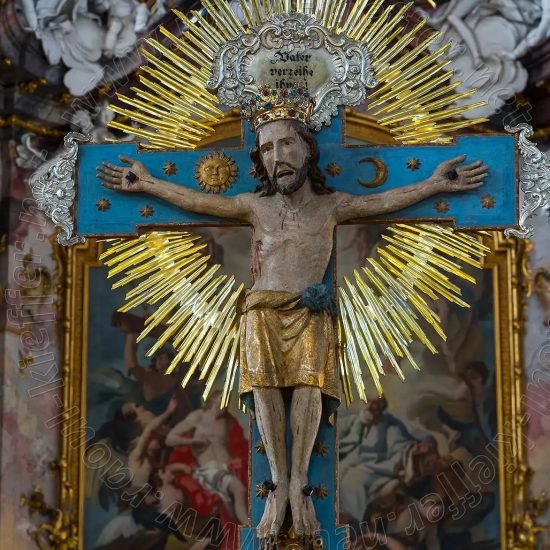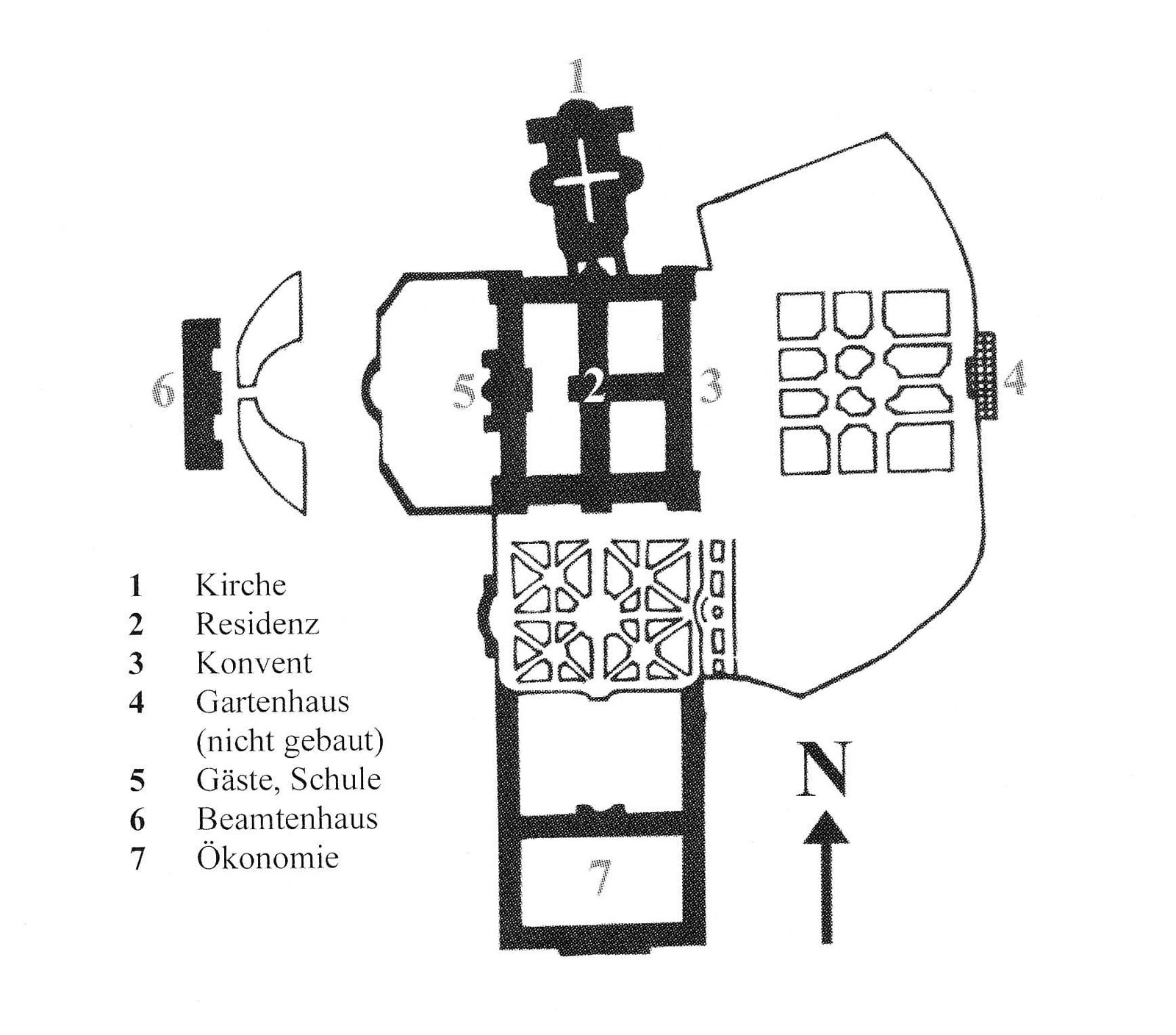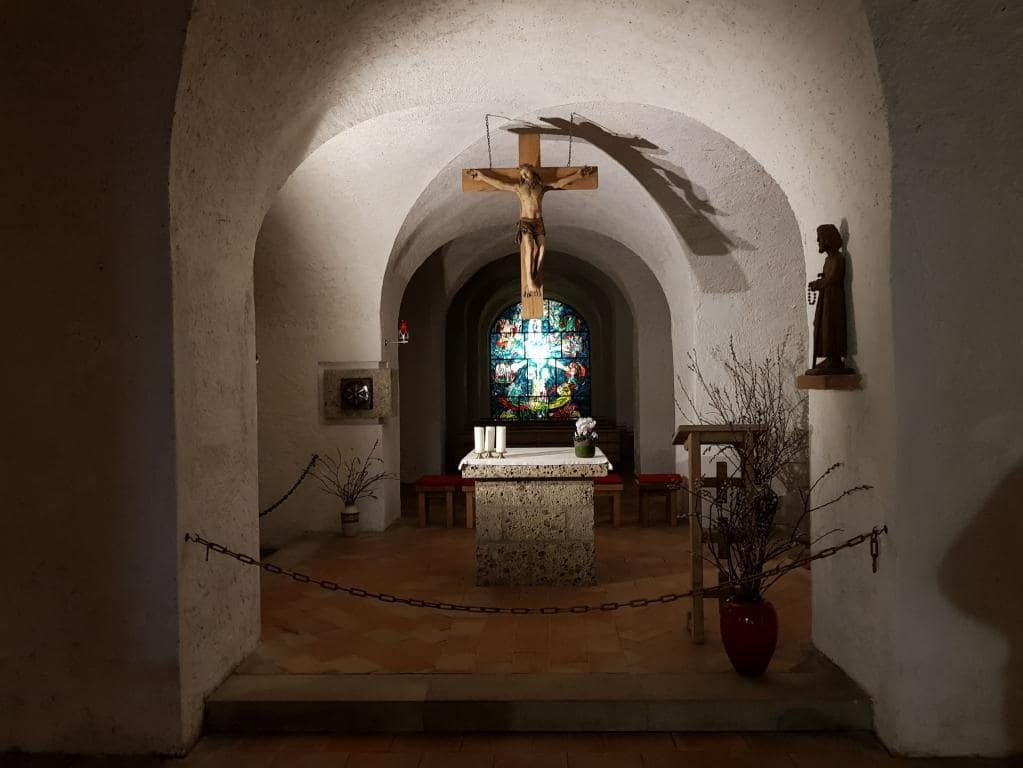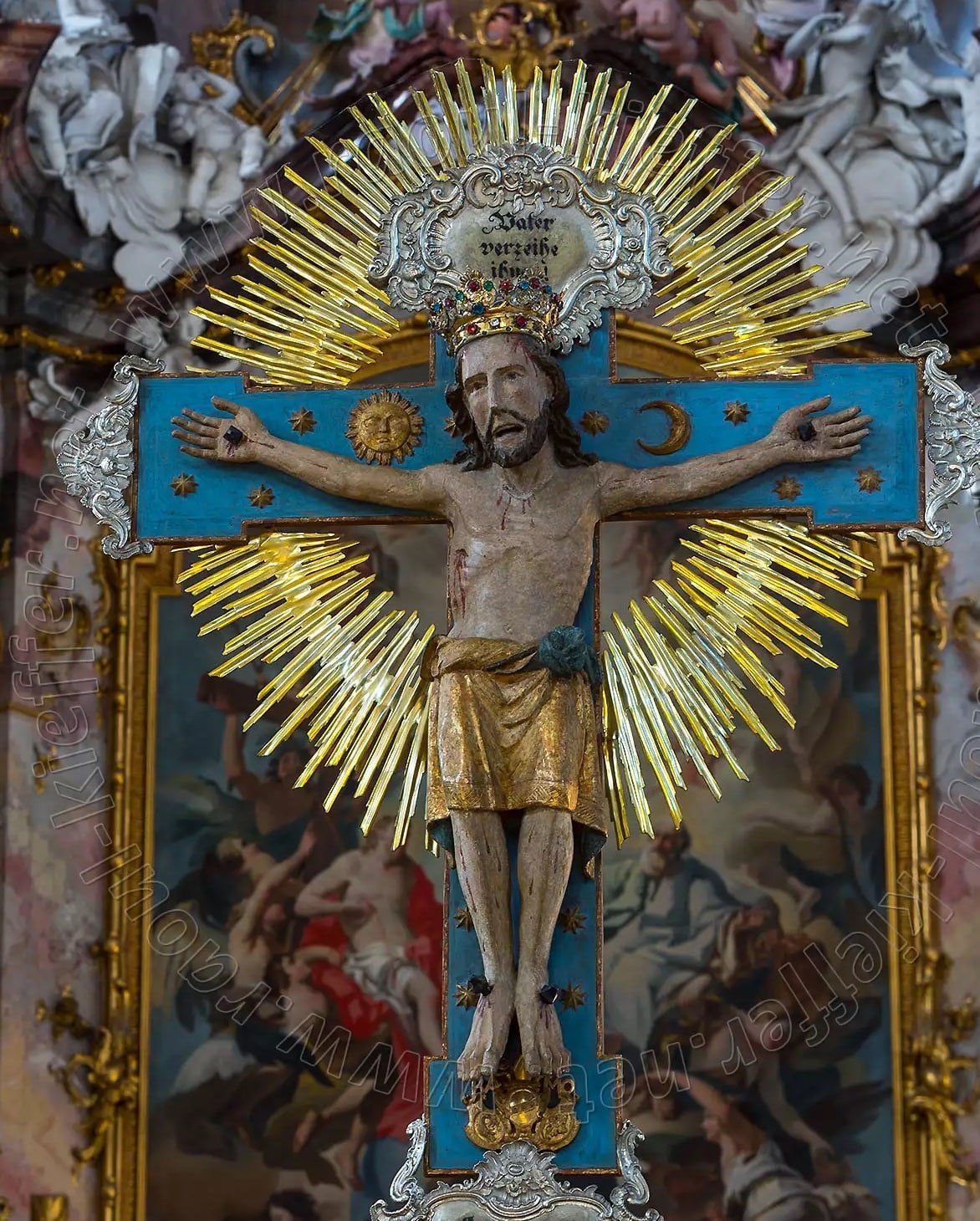The Benedicte Abbey of Ottobeuren
per person
Ottobeuren is located in the region of Oberschwaben near the alpine region of the Allgäu in the province of Baden-Würrtemberg. The town is situated between within a flat valley, through which the small tributary of the Danube river, the Western Günz, is traversing. More broadly, Ottobeuren is situated in relatively close proximity to the Bodensee and the prominent monasteries of that region. In contrast to other municipalities, several hundred homesteads, a small church and a nobleman‘s fortification can be traced back to before the foundation of the convent.
The origin of the convent goes back to the year 764 when monks of Reichenau and Saint Gallen received a donation from the count (comes) Silach and his wife Ermenswint, in order to ensure continued prayer service to the dead of the family and a joint familial sepulchre. Since the monks did not receive any reliquaries with their foundation, the beginning of the monastery sees the theft of the relics of the martyr Saint Alexander from the Cathedral of Vienne by the two sons of count Silach, Gauzipert and Toto. Toto was the chamberlain of the Bishop of Vienne at the time, which not only explains the success of the operation but also exemplifies the interconnectedness of Carolingian Europe. Consequently, Silach also appointed his son Toto as the first abbot of Saint Alexander‘s monastery. He served until 815 or 817 and there is little known about his direct successors. In 830, the first reliable documentation mentions the convent in the fraternity book (Liber memorialis) of Reichenau, showing the continued connection to its motherhouse and attesting 22 monks at Ottobeuren. The convent was to grow to 100 members in the course of the century. Within the long history of Ottobeuren four Golden ages can be identified:
(1)In the course of the 10th century, the convent lost the privilege to elect its own abbot due to the domination of a local count. However, the count‘s nephew and Bishop of Augsburg, Ulrich, managed to receive imperial immediacy for the abbey from Emperor Otto I. in 972/3. In the following decades, Ottobeuren obtained large properties in the surrounding area with resulting economic growth.
(2)The 11th century brought moral decline to the abbey, which was just halted by the appointment of Rupert I and the instatement of the ‚reforms of Hirsau‘. These sought a moral renewal by appointing pious friars from other convents and founding a Scriptorium, as a means to keep the monks busy by copying manuscripts, instead of indulging in earthly vices. In the late 11th and early 12th centuries, the convent fell victim to fire twice and was rebuilt just as often. As of the 14th century and in face of the plague, Ottobeuren again experienced a steady decline, losing many estates to pay for the opulence of an almost temporal abbotship, reaching its lowest point in the 16th century. In the time of the German peasants‘ revolt, the abbey was sacked in 1525 and for a time, a mercenary installed himself as ‚abbot‘ exploiting and abusing the fraternity.
(3)But with the reinstatement of order, Ottobeuren developed to become a centre of early Humanism in southern Germany. Already in 1509, the monastery had a printing press and in 1540, it founded a public school dedicated to teaching oriental languages. In 1543, an attempt was made to found a University of Ottobeuren, which was, however, relocated in the following year to Elchingen. The convent was also remodelled in the style of the Renaissance. However, the Thirty Years War made an end to this steep progress, as Ottobeuren was occupied and raided several times by Swedish and French troops.
(4)Prosperity returned with the Baroque. In 1710 Rupert II Neß was elected to the abbotship. He regained the imperial immediacy of Ottobeuren, which had been lost to Augsburg, making Ottobeuren an imperial abbey, with respective elective rights in the imperial curia. In order to reflect this ascendancy, he undertook the large-scale reconstruction of the convent in the style of the Baroque, which can still be observed today. In the course of the Secularization, the convent was officially dissolved in 1802, however, 18 of the 48 friars were permitted to stay and continued their worship under difficult circumstances, until it was reinstituted in 1834 as a Priory – again under the authority of Augsburg. Finally, in 1918, Ottobeuren again became an independent abbey, which still persists today with currently 15 monks.
FORMAL ANALYSIS
Most noticeable is the layout of the abbe, as it isn‘t directed towards the east, but from south to north. The bird‘s eye view easily reveals the cross-shaped arrangement of the buildings. The church (feature 1) is purposely inclined slightly westwards, representing Christ‘s head on the cross. The torso is constituted by the convent (feature 3), the abbot‘s residence (feature 2) and a tract for guests (feature 5). In this way, the layout is also meant to represent Christ‘s dual nature. The eastern side of the abbey is devoted to the spiritual side, while the eastern side represents the human and temporal domain. The abbot‘s residence, at the heart, unites these opposing principles, reflecting the abbot as both a spiritual and temporal authority in historical times. St. Alexander‘s and Theodor‘s Basilika in itself also has a cross-shaped layout. Two 82 meters high towers are placed on each side of the northern facade. The front has one main portal and two smaller doorways flanking the sides of the protruding entrance hall. Above the three arched windows, there is a statue of the archangel St. Michael, confronting the visitor with the Latin phrase „Quis ut Deus“ (‚Who is like God?‘), on top of which the statue of St. Benedict, the founder of the monastic order, is accompanied by St. Alexander and St. Theodor, the patrons of the convent, who sit on the ends of the gable. The all-seeing eye of God reigns supreme above the very rooftop. Within the eastern tower of the northern facade, a funerary chapel was made for abbot Rupert I. in honour of the 1200 years anniversary of Ottobeuren in 1964. The contemporary wall painting is contrasted by the original romanesque stone sarcophagus within the reliquary shrine.
The interior is mostly fashioned in the style of the late Baroqu. The ceiling is divided into three domes along the nave and two arches of the transepts, each of which are decorated with frescos. The most prominent fresco is the ‚Benediktinerhimmel‘ (‚heaven of the benedictines‘), depicting Saint Benedict in the centre of the fresco, as he is uplifted by a host of angels to see God and Reality clear in its totality. On the borders, those saints who lived according to the benedictine code encircle their patron. 24 pillars carry the transept of the Basilika, representing the 12 tribes of Israel and the 12 apostles respectively and leaving room for a crypt below it. The biblical depictions in the crypt differ widely in style from the Baroque pomp found otherwise in the whole convent, and as the place is still used in the worship of the brotherhood, the depictions are meant to invite the monks to withdraw from daily life and attain a meditative state.
In the southern section of the nave, just after the intersection, visitors will find the altar of the Holy Cross with its romanesque crucifix dating to the 13th century, behind which the high altar is situated. All depictions of the high altar are devoted to the Trinity. The dome fresco of the choir – the ‚Engelshimmel‘ (‚heaven of the angels‘) – sees the infant Christ sitting on the lap of God the father together with the dove, representing the Holy Spirit. Chancels are flanking the high altar from both sidesl, providing seats for the abbot and the monks.
At the same time, following either of the chancels southward one is led into the actual convent, which is partly accessible to visitors via guided tours and the convent‘s museum. Herein, the many highly decorated halls reflect the power and wealth of the abbey in historic times. Especially the ‚Kaisersaal‘ (‚Emperor‘s hall‘) and the theatre hall embody the political consciousness, as well as the cultural flowering during the Baroque era. The library of the abbey goes back to the time of its foundation around the late 8th century. The Scriptorium, founded by Rupert I, would have been part of this old library. Just like the rest of the convent, the library is decorated in Baroque style and also harbours a painted ceiling. The library is accessible for scientific purposes but requires an application. It contains many medieval manuscripts, 457 incunabula (early printed books) and up to 15.000 folios.
FLORIAN HARTMANN
- THE BENEDICTINE ABBEY OF OTTOBEUREN© PHOT. Martin Moxter, www.allgaeuer-zeitung.de ‚Allgäu für die Sinne‘: Sehenswürdigkeiten und Ausflugstipps für Besucher in Ottobeuren
- © PLAN. Layout of the abbey, Rupert Prusinovsky OSB: Benediktinerabtei Ottobeuren, Ottobeuren 2008; www.abtei-ottobeuren.de, Die Gebäude. Die Gesamtanlage, last retrieved 24.10.22.
- LAYOUT OF ST. ALEXANDER‘S AND ST. THEODOR‘S BASILIKA© PLAN. www.abtei-ottobeuren.de, Die Gebäude. Die Basilika, last retrieved 24.10.22
- VIEW INTO THE NAVE DECORATED IN BAROQUE FASHION© PHOT. Diego Delso: www.wikipedia.de. St. Alexander und Theodor (Ottobeuren), last retrieved 24.10.22
- NORTHER FACADE OF THE BASILIKA. NOTE THE TWO FLANKING TOWERS AND THE PROTRUDING ENTRANCE HALL© PHOT. Diego Delso: www.wikipedia.de. St. Alexander und Theodor (Ottobeuren), last retrieved 24.10.22
- PAINTED WALL, RELIQUARY SHRINE AND ROMANESQUE STONE SARCOPHAGUS IN «RUPERTUS CHAPEL»© PHOT. www.abtei-ottobeuren.de. Die Gebäude. Die Rupertuskapelle im Ostturm, last retrieved 24.10.22
- VIEW INTO THE CRYPT, SITUATED BELOW THE TRANSEPT IN THE BASILIKA© PHOT. www.abtei-ottobeuren.de. Die Gebäude. Die Bruder-Klaus-Krypta, last retrieved 24.10.22
- CLOSE-UP VIEW ON THE ROMANESQUE CRUCIFIX DATING TO THE 13TH, 1220© PHOT. https://www.raoul-kieffer.net/es/Pa%C3%ADses visitados/Alemania/Baviera/ Abad%C3%ADa-de-Ottobeuren
- THE LIBRARY OF THE ABBEY© PHOT. https://sonurai.com/bingwallpapers/OttobeurenBibliothek
Información de la localidad
The Benedicte Abbey of Ottobeuren
| Other monuments and places to visit | Ottobeuren Marketplace, Museum of Contemporary Art - Diether Kunerth, Erich-Schling-Foundation |
| Natural Heritage | Geological organs |
| Historical Recreations | |
| Festivals of Tourist Interest | |
| Fairs | |
| Tourist Office | Ottobeuren Tourist Information, Marktpl. 14, 87724 Ottobeuren, Germany, Telef.: +49 8332 921950 |
| Specialized Guides | |
| Guided visits | |
| Accommodations | Best Western Plus Parkhotel Maximilian Ottobeuren, Bannwaldweg 11, Ottobeuren, Telef.: 34 960 105 957. AKZENT Brauerei Hotel Hirsch, Marktplatz 12, Ottobeuren, Germany, Telef.: 34 960 105 957 |
| Restaurants | Wirtshaus am Markt, Marktpl. 9, 87724 Ottobeuren, Germany, Telef.: 49 8332 2809800 Gaststätte Primrose, Luitpoldstraße 6, 87724 Ottobeuren, Germany, Telef.: 49 8332 937390 |
| Craft | |
| Bibliography | |
| Videos | bergfex.es |
| Website | ottobeuren.de |
| Monument or place to visit | Benedictine abbey of St. Alexander and St. Theodor in Ottobeuren |
| Style | Grand monastery complex for the most part in style of the later Baroque. Some traces and relics of the Romanesque period remain. |
| Type | Monastic and ecclestiastical architecture |
| Epoch | 8th-19th centuries |
| State of conservation | Excellent condition |
| Mailing address | Contact form available under: poststelle@abtei-ottobeuren.de |
| Coordinates GPS | Längengrad: 49°00′54″ Breitengrad: 12°06′06″ |
| Property, dependency | Diözese Augsburg |
| Possibility of visits by the general public or only specialists | The Basilika can be visited at any time and free of charge. Parts of the convent complex will reopen to the general public as of 2023. |
| Conservation needs | Yes |
| Visiting hours and conditions | |
| Ticket amount | 4 euros |
| Research work in progress | |
| Accessibility | Good |
| Signaling if it is registered on the route | |
| Bibliography | Magnus, Bernhard: Beschreibung des Klosters und der Kirche zu Ottobeuren, Ottobeuren 1864 (retrievable under: https://www.digitale-sammlungen.de/de/view/bsb10371355?q=Ottobeuren). Schaber, Johannes, ‘Heilig ist dieser Ort’. Die Benediktinerabtei Ottobeuren im Bild, Ottobeuren 2019 Prusinovsky, Rupert: Benediktinerabtei Ottobeuren. Basilika St. Alexander und Theodor, Ottobeuren 2008. Schwager, Klaus: Die benediktinische Reichsabtei Ottobeuren 1672-1803. Materialien zu Vorgeschichte, Planung, Bau und Ausstattung der neuen Klosteranlage sowie anderer Bauten des Ottobeurer Einflußbereichs Teil I (1672-1740), Lindenberg 2017. |
| Videos | |
| Information websites | abtei-ottobeuren.de abtei-ottobeuren.de republica.com hmong.es baroqueart.museumwnf.org |
| Location | Ottobeuren, Bavarian Swabia, Germany |


